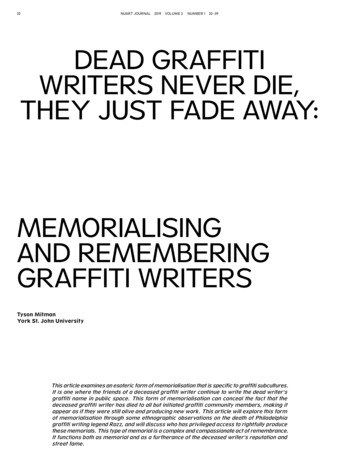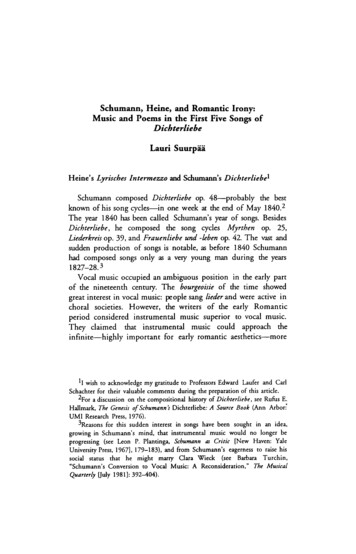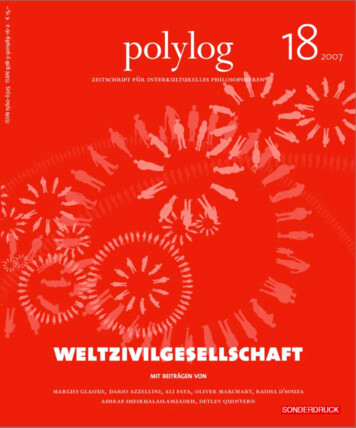
Transcription
32NUART JOURNAL2019VOLUME 2NUMBER 132–39DEAD GRAFFITIWRITERS NEVER DIE,THEY JUST FADE AWAY:MEMORIALISINGAND REMEMBERINGGRAFFITI WRITERSTyson MitmanYork St. John UniversityThis article examines an esoteric form of memorialisation that is specific to graffiti subcultures.It is one where the friends of a deceased graffiti writer continue to write the dead writer'sgraffiti name in public space. This form of memorialisation can conceal the fact that thedeceased graffiti writer has died to all but initiated graffiti community members, making itappear as if they were still alive and producing new work. This article will explore this formof memorialisation through some ethnographic observations on the death of Philadelphiagraffiti writing legend Razz, and will discuss who has privileged access to rightfully producethese memorials. This type of memorial is a complex and compassionate act of remembrance.It functions both as memorial and as a furtherance of the deceased writer's reputation andstreet fame.
DEAD GRAFFITI WRITERS NEVER DIE, THEY JUST FADE AWAYWhen someone who was cared for dies it is standardpractice to remember and memorialise them. In westerncultures that way often manifests as a funeral service anda gravestone to commemorate their existence. There are,of course, many other ways a person can be memorialisedand many other small rituals of remembrance that thosewho cared about the departed participate in. Dependingon who that person was, their personal beliefs and culturalbackground, what they did while they were alive, and thegroups that they were part of while they were alive, theserituals of remembrance can take many forms. Private,personal memorialisation among those who knew thedeceased are most common, but forms of public tributeare also typical. A dedicated bench in a park, or a treeplanted with a plaque to show passers who it was plantedfor, or a donation made in a dead loved one's name so thattheir name will appear on a public list, are some typicalways that the living publicly remember their dead.When the deceased is someone who had cultivateda public reputation, the forms of memorialisation expand.Frequently, they are retrospectives of the deceased's career;performance highlight reels, pieces they are best remembered for, or stories shared about how they made theirmark on their chosen fields. In the digital age, social mediahave become a very capable outlet for producing thesekinds of memorials. Facebook pages (and similar formsof social media) of the deceased become spaces wherestories, memories, and condolences for and to the departedare shared (Brubaker, Hayes, & Dourish, 2013). And platformslike Instagram offer spaces for users from all over theworld to display tributes or RIP pieces, and to comment onthe impact the individual, or their work, had on them. Thesespaces become crucial spaces of public memorialisationthat anyone can observe (assuming the pages are publiclyshared) to know that someone has died, and that thatsomeone was important to, and impactful on others. All ofthese forms of remembrance do at least two importantthings; (1) they remember the deceased and (2) they publiclyacknowledge that the person being remembered has diedand thus will not produce new work.This article will examine a different type of memorialisation, a more esoteric one that takes place in graffiticommunities where the graffiti writing friends of thedeceased continue to write the dead graffiti writer's name.This form of memorialisation can conceal the fact that thedeceased graffiti writer has died to all but the initiatedgraffiti community members, while also furthering thedead writer's graffiti presence in the collective memory ofthe graffiti community and on the physical spaces of theirparticular graffiti locale (as such it will forego a discussionof digital memorialisation and tribute, leaving that discussionfor another time). It is typically only understood by theproperly initiated and can mask the dead graffiti writer'sdeath from the general public, making it appear as if theyare still alive and producing new work. This article willexplain through ethnographic example this form ofmemorialisation, and it will discuss who has privilegedaccess to rightfully produce these memorials. It will makethe case that this type of memorial is a complex andcompassionate act of remembrance done to keep thedeceased graffiti writing entity alive in the streets, and itis one that inducted graffiti writers spot immediately. Assuch, it is a form of public memorial in line with the traditional types of public memorialisation (dedicated benches,trees, etc.), but it is also one that functions both as memorialto those in the subculture and as a furtherance of thedeceased writer's reputation and street fame to both those33inside and outside the subculture. This process will beexamined through the death of Philadelphia graffiti writinglegend Razz.In the history of Philadelphia graffiti there are manyshining stars; Cornbread, Mr. Blint, Estro, Disko Duck, Kair,Espo, to name a few. But no list of Philadelphia graffitiluminaries would be complete without including Razz. Razzwas a true graffiti presence on the walls of Philadelphia inhis time. He was ‘all city’, which means he had his graffitiup in all neighbourhoods of Philadelphia. He founded theLAW1 graffiti crew and was their president for years. Inthat capacity, he mentored many young graffiti writers andmade sure they knew how to write graffiti properly, andknew how to respect the culture and traditions of Philadelphiagraffiti. His place in the graffiti subculture as a whole wasassured when he had an entire section devoted to him inthe classic graffiti culture book The Art of Getting Over(Powers, 1999), which explained graffiti to so many whohad seen it but not understood it. He died on May 5, 2012,and so the community lost one of its longest standing andmost important members. Of course, he had to be remembered, celebrated, and memorialised. The Philadelphiagraffiti community would come together to do just that.And in so doing they would teach a lesson about how theculture remembers its fallen practitioners, and how graffitiwriters all over the world understand their identity andsocial presence.There is an old saying that says when someone diesthey really die three deaths. The first is their physical death,the second is when the people who knew them die or forgetabout them, and the third is when they are forgotten by allof society because what they have created disappears, oris lost, or forgotten. This is a fitting adage for how graffitiwriters understand death in terms of their graffiti identity.It also allows us to more clearly understand the process ofmemorialisation that graffiti writers undertake.What follows are my field notes 1 from the night ofRazz's memorial held by the graffiti community with onlyminimal editing for clarity and linearity. Succeeding themare some critical reflections on the events to provide greaterunderstanding of their meaning and importance.Razz died Saturday (5/5/12). I've heard it was fromlung cancer, but haven't read that officially. Baby and Nemapainted a tribute piece together after hearing the news.There's an all crew, all city meet up tonight to honour andremember Razz. Baby is taking me. I'm not sure what toexpect but I'm guessing something in between a wake, aNew Orleans second line funeral, and the opening scenein Warriors (1979).The meet-up is at a restaurant in West Philadelphianear the University of Pennsylvania campus. Baby, Lady,Nema, and I arrive together and Nema and I go to the barand grab a drink. Baby and Lady go over to where everyoneis meeting. The memorial group is largely African Americanmen who are in their late 30s to early 40s. I get the feelingthat this bar is not used to having this many black men init, especially when some of them fit the media-established‘thug’ aesthetic. They are passing around blackbooks 2 ,standing in the lanes between tables talking and being inthe waitresses’ way. A few times what I'm guessing is theowner comes out and eyeballs the crowd with clear disdain.The crowd is largely members of the graffiti crewRazz founded, LAW1. I meet Bum, Bard, Demo, Expo, Caze,and a bunch of other people. Once everyone has settled in,blackbooks get passed around and people section off intolittle groups and watch each other write in the books and
34NUART JOURNALpass them around to get more names in them. After justabout every tag I see people do they write ‘RIP Razz’ nextto it. Some just write their tag and then Razz next to it inRazz's famously straightforward style, making sure toconnect the R and the A.The night is dwindling down, people are shuffling outslowly and a lot of people are still out front smoking andtalking. Outside it has started raining and those who areout there are standing under an awning close to the doorfor cover. All of a sudden everyone comes back insidehurried in by the ‘owner’ and five cops. The ‘owner’ andthe cops walks over to the area where everyone is sittingand the owner says ‘you all smell like weed, get out’, thecops say, ‘alright, that's the end of your night’ and hustleeveryone outside. Nema and I slide to the bar and escapefrom the fray without being noticed, Baby and Lady areaway from it all anyway and a few old heads are not hassled.But anyone who looked ‘urban black’ got thrown out. Baby,Lady, Nema and I sit at the bar until this all calms down.We settle our tabs and go outside, fuck this place now.We all congregate in the front alcove to get out ofthe rain, and Expo goes back inside to investigate why thecops got called and everyone got thrown out. He finds outit is as the ‘owner’ said, because people were smokingweed out front and it was wafting in through the door andbothering patrons. This is a legitimate complaint, but italso feels like a convenient excuse for getting rid of patronsthat were deemed unsavory.The biggest issue is that when the cops threw everyone out they confiscated all the blackbooks. Everyone isreally upset about this. These were not just ordinaryblackbooks, which would be a big enough shame to lose,these were ones that are full of memorials to and memoriesabout Razz. Everyone seems to agree that even if someonewent down to the police station the next day there is littlechance of getting them back.The rain has slowed to a drizzle and those who arestill hanging around are talking about going painting. It feelslike the right next step in the celebration/memorialisationof Razz, but people also want to go as a kind of ‘fuck you’to the police who hassled everyone and seized the blackbooks. Caze says he knows a spot we can go paint, but hehas to go home first. He says he'll text us in a bit. In themeantime Baby, Nema, Lady, and I get in my car and justkind of start driving around. It feels risky to keep standingaround in front of where everyone just got thrown out of.So we leave without a destination in mind.We drive around for a bit and end up in the northBroad St. area. It's late enough and dark enough that Babyand Nema want to do some hop outs. When the coast isclear I pull over and they hop out and catch tags on the sideof a building. After their tags they write ‘RIP Razz’, but thenBaby walks a few feet and puts up a Razz tag in his style.Nema sees this and does the same. They get back in thecar and I ask them why they put up Razz tags and Nemasays ‘gotta keep his name alive in the streets.’ (field notes)As that night continued, we ended up painting somethrow-ups 3 under a bridge since the rain picked back up.But the events of that night up to this point are very tellingwhen it comes to understanding how graffiti writers thinkabout their presence in (and on) the city and how thatpresence affects their subjective identity. They also exemplify how graffiti writers think about their relationships toeach other, and how they conceive of their legacy of graffitiwriting. The most important thing that happened was bothBaby and Nema engaging in a form of memorialisationwhere they put up Razz's tag as true to his original style asthey could.Before we can move on it has to be noted that thisresearch took place in Philadelphia, and that Philadelphiais where graffiti as an urban aesthetic practice basedaround forms of competitive recognition began (Mitman,2018). This does not mean that this particular form ofmemorialising deceased graffiti writers is exclusive toPhiladelphia; quite the opposite in fact, as will be shownat the end of this article, this practice takes place in manygeographically disparate communities. But since Philadelphiahas a long history of graffiti on its spaces and an intricate,culturally understood system of guidelines that tell graffitiwriters what spaces are and are not acceptable for graffiti,it is important to acknowledge the location and the associatedcultural history. Further, it is important to understand thatthe guidelines of graffiti practice that will be discussed arejust that, guidelines. These guidelines are internally imposed by the graffiti culture, but it is up to the individualgraffiti writer to choose how closely (if at all) they adhereto them. Because one of the ways the graffiti communitythinks of itself is as anti-authoritarian rebels (Macdonald,2001), the degree to which these guidelines are adhered towill vary. Some writers will adhere to them strictly, whileothers will choose to only abide by the ones that areconvenient for them in the moment, others may ignorethem entirely. The one aspect of the rules that has someuniversality, though, is that when a writer feels anotherwriter has violated their public graffiti presence, or that awriter has violated the community standards, it is thiscollection of guidelines that get referenced as supportingevidence for the claim (Mitman, 2018).The guidelines lay out forms of acceptable culturalpractice (see Powers, 1999: 154 –155, or for a morecomprehensive discussion, see chapter 3 of Mitman, 2018).One of the important things they describe is how and whenexisting graffiti can be painted over so new graffiti can becreated. In their most rudimentary form, these guidelinesapply a visual hierarchy to graffiti saying that a piece 4 isbetter than a throw-up, and that a throw-up is better thana tag 5. As such, when it comes to reusing space that alreadyhas graffiti on it, a piece can be put over a throw-up, anda throw-up can be put over a tag. This simple guideline isone that is naturally understood in all graffiti communities,but in Philadelphia this particular rule is complicated by thefact that the Philadelphia graffiti community holds the tagin very high regard. A well-executed tag (particularly aPhiladelphia-specific style like a wicked, a tall hand, or agangster hand 6) can be as well respected as a throw-up,and as such putting any graffiti other than a piece over itcan be considered an act of disrespect.This matters for this discussion for two reasons.One is that good tags, and tags of well-known graffiti writerstend to remain untouched much longer on city walls inPhiladelphia, unless the city or the owner of the space buffsthe space clean, which they tend to do indiscriminately. Thesecond reason is that it is absolutely forbidden in the graffiticommunity to ever paint over a dead writer's work. Theyare not alive to produce more and, obviously, they are notable to retaliate or reclaim their name, so painting over adead writer is considered one of the most reprehensibleand disgraceful things a graffiti writer can do. Paintingover their tags serves as an act of erasure that diminishesthe deceased writer's public presence and acts as onemore step toward erasing them from history and publicmemory altogether. It can cause the dead writer's friendsto seek retribution against the graffiti writer who went over
DEAD GRAFFITI WRITERS NEVER DIE, THEY JUST FADE AWAYtheir dead friend. It can also damage the offending writer'sfuture chances of recognition and participation in thatgraffiti community. A graffiti writer who paints over a deadwriter's work, even accidentally, can suffer great reputationdamage within the community which can cause other writersto target their work, be unwilling to paint with them, or justgenerally be unwilling to associate with them in any way.This can be detrimental to a graffiti career because, whilethe quality and quantity of work a writer puts up is criticalto their graffiti reputation (Schacter, 2008), equally importantis their involvement in, and recognition from the rest of thegraffiti community (Halsey and Young, 2006). Simply put,painting over a dead writer's work is considered soobjectionable that it puts an offending writer in bad standingwith the overwhelming majority of their graffiti community.So, what Baby and Nema did (and what many otherwriters did in the days after Razz's death as well), was asimple act that had embedded in it a great deal of compassionand complexity. Putting Razz's tag up helped to ensure hispresence on the streets and in the collective memory ofthe graffiti community and city. It is often said that graffitiwriters primarily write graffiti for fame (Castleman, 1984;Lachmann, 1988; Ferrell, 1996; Powers, 1999; Snyder, 2009),and to achieve fame they must go out and endure the risksassociated with illegal graffiti writing. These risks, amongothers, come in the form of risks to their freedom frombeing arrested, and risks to their personal safety frompotential assaults from the police or fellow writers, or fromgetting injured while entering abandoned and/or dangerousplaces. Additionally, writers endure risks to their personalfinancial well-being because if they are caught and arrestedthe punishment they receive from the court is most oftena hefty fine. What this means then is that to accept the risksof writing graffiti and to eschew writing one's own graffitiname (thus diminishing the collective amount of fame theycan achieve from their graffiti writing efforts) in favor ofwriting their dead friend's name, is a compassionate actof memorial.35This form of memorialisation, where the friends ofa dead writer go out writing graffiti and also put up theirdead friend's tag in as close to that dead writer's style asthey can, is complex as well. It serves as a noteworthyform of remembrance in two ways.One, the act of going out and writing with otherwriters in the service of putting up a dead writer, functionsas a kind of ritual of remembrance. It can serve as a typeof psychotherapeutic act (Reeves, 2011) that allows writersto process the loss of their dead friend, while also actingas a type of catharsis that allows them to let go of some oftheir negative feelings about the loss. I have writtenpreviously about how graffiti writers use the act of writinggraffiti as a cathartic form of art therapy that allows themto process and deal with personal issues (Mitman, 2018).In this instance, writing a dead friend's tag functions as akind of praxis (Arendt, 1998) where the graffiti writer iscognitively, physically, and emotionally engaged with theirparticular way of grieving that is associated with the actof memorialisation of putting up their dead friend's graffitiname. This practice offers the grieving graffiti writers atype of catharsis, while also creating a community ofremembrance through all those graffiti writers who wentout and put up Razz tags in the time after his death.Going out and writing a deceased friend's tag, andseeing that others have done the same, reinforces thesense of belonging and friendship within the graffiticommunity. Halsey and Young (2006) describe how importantit is for graffiti writers to feel like they are an integratedpart of a larger community through friendships with vettedmembers, as do Castleman (1984) and Monto, Machalek,and Anderson (2012). Going out writing graffiti with friendsto remember and memorialise a dead friend attends to thiscrucial part of cultural participation, but it also strengthensthese feelings of friendship and community integration thatare so important and motivational to so many graffiti writers.Figure 1. Original RAZZ tag, Philadelphia.Photograph Instagram user talkingwalls215.Figure 2. RAZZ memorial piece. BABY and NEMA. Philadelphia.Photograph Instagram user talkingwalls215.
36NUART JOURNALFigure 4. RAZZ memorial piece on a wall permitted by Mural ArtsPhiladelphia. Shameak LAW1. Photograph Instagram user freshpaintnyc.Figure 3. RAZZ memorial tag. Philadelphia.Photograph Instagram user juspix.These feelings are strengthened in another way aswell. When writers see their dead friend's tag up, and knowthe tag was done after their friend's death but do not knowwho did it, this expands their feelings of connection andinvolvement and creates a kind of semi- anonymouscommunity of remembrance. This increased feeling ofinterconnectedness occurs because when writers see theirdead friend's tags appear on the walls after they have died,it indicates that other writers cared about their friend in asimilar way and are equally willing to engage in personalrisk-taking to continue to propagate that individual's graffitipresence in the city.A dead writer becoming more present on the citywalls after their death serves as evidence of the impactthat their existence had on the graffiti community. Whetherit is many writers putting them up, a few, or even just onededicated writer, the fact that those in the graffiti communitycan know a writer has died and see that writer's representedness increase, shows that they were an embedded andimportant enough part of that graffiti scene for someoneto continue their legacy. This act then bonds those who doit to each other through a shared friendship with the deceasedwriter, and more firmly enmeshes both the dead writer andthose reproducing their tags into that graffiti community.This point comes with a caveat though. For this actto be respected as a legitimate type of memorial by thegraffiti community, it must be at least tacitly understoodthat those writers putting up their dead graffiti friend wereindeed friends with the departed. As previously stated,friendships are of critical importance to graffiti writers andthese typically include things such as being prepared to beon the lookout while a fellow writer is painting, or helpingto resolve any ‘beef’ that may arise. This could be by actingas an intermediary or negotiator between parties, or assomeone willing to fight by your side to resolve it, or theycould act in myriad other supportive roles.In graffiti communities, friendships can also serveas a type of subcultural capital (Thornton, 1996). Beingfriends with a well-known and respected writer can conferincreased subcultural status onto their friends. As such, itmatters that there was a legitimate interpersonal connectionbetween the graffiti writers, because when doing this,graffiti writers will most often write their name and theirdead friend's name thus associating the two together. Ifthe graffiti community does not believe the writer puttingup the dead writer's name was a friend of theirs, the actis then considered an act of appropriation. It can be seenas a disrespectful and offensive act done to achieve a quicktype of illegitimate street fame by associating one's graffitireputation with a well-known and now deceased graffitiwriter. It is thought of as a type of attempt at reflectednotoriety dishonestly cast from the dead writer's nameonto theirs; a kind of theft of subcultural capital.Two, putting up a dead writer more indelibly (literally)marks them on the city. This is very important. Having avisual presence on the streets (or as graffiti writers say‘being up’) is the primary way that graffiti writers competewith each other and cultivate reputation. It is also the waywriters stay relevant members of their graffiti scenes. Assuch, the longer a writer is active in their graffiti scene andthe longer their graffiti work lasts on the walls, the moretheir reputation and importance to that graffiti communitywill grow. One of the best strategies for writers to acquirefame is to stay active for a long time. The two biggesthin d ra nces to m aintaining a ctive pa r ticipatio n a reincarceration and death. A graffiti writer stopping for any
DEAD GRAFFITI WRITERS NEVER DIE, THEY JUST FADE AWAYother reason is considered to have quit or retired. Thecommunity believes that if they were truly dedicated, theywould overcome whatever barriers they face to get backout there and continue the practice of graffiti writing. Assuch, putting up a dead graffiti writer's tag serves tomaintain their presence both visually and ideologically tothat graffiti community. This can be clearly seen in Babyand Nema putting Razz's tag up on the wall, and by howNema exhibits his understanding of this process when hesays ‘gotta keep his name alive in the streets ’. Putting upRazz's tag furthers his presence on this city, continues hisparticipation in the graffiti scene, links him visually andconceptually to those graffiti writers currently producinggraffiti (as opposed to those who have for whatever reasonstopped), and functions as a memorial for those who areintegrated enough to understand it as such. This is importantbecause maintaining public presence can be very difficultfor writers. They see themselves in a constant battle against‘the buff’.‘The buff’ comes in many forms, but it generallymeans for a writer to have their graffiti obliterated frompublic view by some authoritative structure. It is such aconcern in graffiti communities that the process getsembodied as an entity simply called ‘the buff’, that writersenvision themselves in a constant war against. When thecity decides to buff a space, they literally can erasegenerations of graffiti history from the walls. Entire careerscan be annihilated when a city undertakes a dedicatedgraffiti cleanup effort. And those who cannot reassert theirpresence can be eradicated from the collective memoryof their graffiti community. Successful graffiti writers arethose who continue to put up new work to compensate forwhat is lost, and who increase their fame by improvingtheir skill, presence, and reputation in the process.Writers paint over each other's work as well. Theyerase each other (though this is not considered part of ‘thebuff’). It is a begrudgingly endured and fairly commonpractice, but painting over a dead writer is absolutely37unacceptable, as it is considered an act of disrespect.Writers work to be aware of each other's status in thecommunity, of who it is they consider going over, and thusof who they are potentially going to offend. What this meansis that the collective graffiti subculture expects its membersto be armchair historians of their local graffiti scene, andto be aware of who other practitioners are and if one ofthem has died. Generally, this sort of information travelsquickly through the community by word of mouth (orknowledge shared via social media). As such, claimingignorance of a writer's death (especially as an excuse forpainting over their work) is not tolerated. Claiming to be amember of the graffiti community, but also claiming to beignorant of the loss of one of its members are irreconcilableclaims.When graffiti writers put up their dead friend in thesame style that friend used it, it is very difficult for theuninitiated to tell what is a memorial and what was actuallyproduced by the dead writer. The average urban residentwill see a memorial of this type and merely think the deadwriter is alive continuing their graffiti career. This is verymuch the point of this act. It perpetuates the idea to thepublic that the dead graffiti writer as an entity in the graffiticommunity still exists and is still producing work, and itincreases the deceased writer's fame.But an additional part of the point of this act is themessage it sends to the aware members of the graffiticommunity. It serves as a memorial or tribute that showsthat other writers care about the friend they lost. Additionally,it being a memorial goes a long way to ensure that it willnot be adulterated or gone over by other members of thegraffiti community. This is because, while painting over adead writer's work is verboten in the graffiti world, paintingover a tribute to a dead writer is almost as offensive and,thus, is guaranteed to bring the offending writer a seriousamount of beef. The dead writer then has a continued andincreased presence in the city from their friends. Theybecome a dead, but active member of the community, theirFigure 5. RAZZ memorial piece. SZ.Philadelphia. Photograph Instagram user razzlaw1 (the page has been maintainedby Razz's son as a digital memorial andtribute space).
38NUART JOURNALmantle carried on by their friends. In this way, a dead graffitiwriter can continue their career for as long as their friendsare willing to put them up. The initiated will see this as asustained act of friendship and remembrance, while otherswill just see a graffiti writer's street fame increasing.The fact that the dead graffiti writer's tags are donein as close to their original style as can be reproduced, isimportant. Partly it is an act of respect done for the deadwriter that reinforces and acknowledges their stylisticcontributions to the graffiti scene. But it also means thatthese new tags intermingle with the existing ones the deadwriter left behind in a way that (hopefully) makes the originalones and the memorial ones hard to distinguish from eachother. In this way the dead writer lives on, but their graffitiidentity is now co-constructed by their friends who put themup, and through the rest of the graffiti community beingaware that the tags they see are simultaneously furthersteps toward fame for the deceased writer and forms ofmemorial to them. The difference between the originaltags and the new, memorial ones is easy for the initiatedto see. The original ones have what Benjamin (2008) callsan ‘aura’. They possess a quality that could only have beenprod
WRITERS NEVER DIE, THEY JUST FADE AWAY: Tyson Mitman York St. John University NUART JOURNAL 2019 VOLUME 2 NUMBER 1 32-39 This article examines an esoteric form of memorialisation that is specific to graffiti subcultures. It is one where the friends of a deceased graffiti writer continue to write the dead writer's graffiti name in public space.










